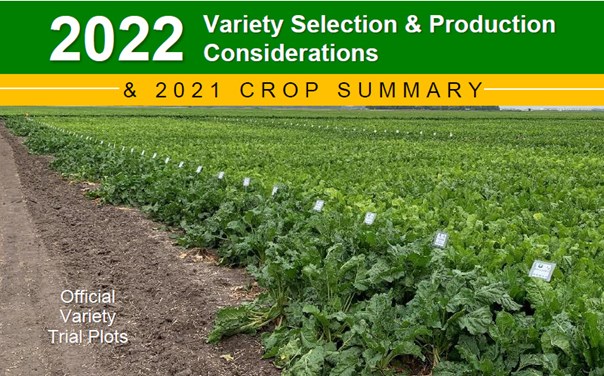621 - 2022 Variety Selection & Production Considerations

Official Coded Variety Performance Trial Data
American Crystal 2021 Official Variety Trial (OVT) data for varieties approved for crop year 2022 has been published and is available here.
Many growers have already purchased seed for the 2022 sugarbeet crop, however it is still important to review the OVT data to make sure that the varieties you’ve selected offer the appropriate characteristics of disease tolerance, yield and sugar quality for placement in each unique field on your farm.
OVT trial data can be downloaded in a PDF document or an Excel file. Both have the same data sorted in 8 different ways. Color coded disease tolerance ratings can help you distinguish between the different degrees of tolerance.
OVT variety data is sorted in the 2021 Variety Selector in the following ways (each on a separate page):
- Seed Company
- Rev/Ton
- Rev/Acre
- Aphanomyces Tolerance Rating
- Rhizoctonia Tolerance Rating
- Fusarium Tolerance Rating
- Cercospora Tolerance Rating
- Emergence Percent
Downloading the Excel version will allow you to create your own sorts to examine the data as well.
Considerations on Variety Placement
- Historical variety performance on your farm.
- Known disease presence in fields to be planted in 2022.
- Production characteristics by field:
- Below average sugar and/or above average tons – consider higher sugar variety to optimize recoverable sugar/acre.
- Above average sugar and/or below average tons – consider higher yielding variety to optimize recoverable sugar/acre.
- Pre-piling from designated fields, headlands and splits – use high sugar varieties to help maximize your Pre-pile Premium
- Field distance from piling site/factory – if long distance, consider higher sugar, moderate tonnage varieties to help lower transportation costs.
Township Disease Severity Maps & Recommendations
Links to general observations on disease presence & management recs for:
• Aphanomyces
• Rhizoctonia
• Fusarium
Production Considerations in 2022
The 2022 crop has both optimism and challenges to prepare for:
- Even though we’ve had some moisture late Summer/early Fall, it hasn’t been enough to completely re-charge the soil profile. For the growing season the RRV is hovering around 70% of normal precipitation.
- These drier soil conditions point to a possible early and timely planting opportunity creating great crop potential, but field preparations need to conserve as much moisture as possible.
- Cover crops should also be used to protect seedling sugarbeets and limit erosion from strong spring wind events.
Weed Control
- All areas of the Red River Valley need to have a plan to control glyphosate resistant weeds, particularly waterhemp and common ragweed.
- For waterhemp, this plan should incorporate a layered approach of soil applied herbicides, that includes a PPI/PRE herbicide application along with 2 POST Lay-by herbicide applications.
- Some pesticide supplies may be limited. Check with your pesticide supplier to make sure you have access to pesticides needed for your 2022 crop production.
Sugarbeet Root Maggot (SBRM) Continued High Pressure
- 2021 saw the highest SBRM populations in recent history. Accordingly populations are forecast to be high in 2022.
- The best SBRM treatment is using Counter insecticide At-Plant followed by POST insecticide applications. Multiple POST applications may be needed for optimal control to reduce the number of flies laying eggs.
- In August, EPA revoked all tolerances of chlorpyrifos (Lorsban), thereby it is no longer an option for SBRM control. Prepare to use Mustang Maxx or Asana as POST liquid insecticides as alternatives. Also, if not doing so, consider using Counter At-Plant and Thimet POST for greater SBRM control.
Cercospora Leafspot (CLS)Cercospora Leafspot (CLS)
- Even with drought conditions this summer, the 1st Cercospora Leafspots were found the last week of June and early July in the RRV.
- Infections came on strong late summer with more favorable conditions. 2022 will have high inoculum levels that will require the need for proactive protection from fungicide applications.
- A timely initial fungicide application will be needed to delay and push back the on-set of cercospora infections to reduce its potential severity.
- Timely initial fungicide application target timeframe:
- Southern RRV: Last week of June
- Middle RRV: First week of July
- Very Northern RRV: Second week of July
- Tank-mix and rotate fungicides for resistance management and maintain proper fungicide application intervals.
- Planting varieties with good CLS ratings can make a big difference in infection levels.
- CR+ varieties still require timely initial and following fungicide applications. Do so to keep this trait working effectively against CLS into the future.
